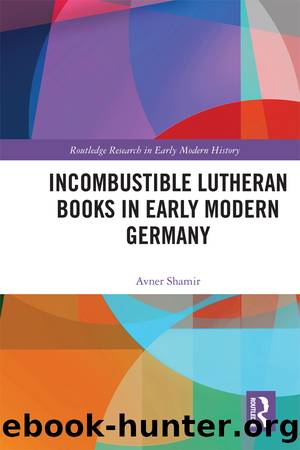Incombustible Lutheran Books in Early Modern Germany by Avner Shamir

Author:Avner Shamir [Shamir, Avner]
Language: eng
Format: epub
ISBN: 9780367151201
Barnesnoble:
Publisher: Taylor & Francis
Published: 2019-01-21T00:00:00+00:00
Some unburnt books became religious objects, others became library items, and a few became both at different times. Like other important libraries, the Royal Library in Berlin, the capital of King Friedrich Wilhelm I of Prussia, also obtained an unburnt book. In late 1733, a double edition of Wahre Christentum and Paradiesgärtlein survived in a fire in Quedlinburg. Its story was later reported as the sixteenth and last wondrous preservation of Arndtâs book in a preface to a later double edition of Arndtâs two books (Züllichau, 1750). Based partly on correspondence between the local governor and a government official in Berlin, the report described how Arndtâs book (Magdeburg, 1727) was wondrously (wunderbar) preserved in a fire that erupted in Quedlinburg on December 5, 1733. The book belonged to one Dorothea Loyse Seiler and happened to be in a wardrobe among clothes and linen. The clothes and linen as well as the wardrobe itself were destroyed by fire, the book, however, was discovered under the ashes in good condition, except for blackened edges and a smell of fire. The governor wanted to send the book to Berlin, but he met strong opposition from âthe peopleâ (den leuten) because of their distress. A month later, the book was nevertheless sent to Berlin and, following the orders of Friedrich Wilhelm I, it was stored at the Royal Library and âcan be daily shownâ to visitors, as the report from 1750 concluded.75 The book remained in the library for two centuries and was lost during World War II.76
In 1838 (or earlier), Friedrich Arndt, the author of a biography of Johann Arndt inspected the book and copied the dedication that was inscribed inside the book by its owner, Dorothea Loyse Seiler, some ten days after the fire. Seiler reported that after the fire, two booksânot oneâwere found in the ashes: Arndtâs Paradiesgärtlein and the small catechism (probably Lutherâs Der Kleine Katechismus). For Seiler, the intervention of the almighty God in the fire testified to the great value of Arndtâs book. She wished that the survival of the Paradiesgärtlein might awaken many souls in Quedlinburg and stir in her great love for Godâs holy Word.77 Seiler recognised the fact that two books were preserved in the fire, yet she privileged the survival of Arndtâs book, perhaps because Arndtâs incombustibility was by now a well-known fact, perhaps because of a special attachment to this particular book, perhaps out of recognition of a special coincidenceâArndt worked as a clergyman in Quedlinburg from 1590 to 1599. Unsurprisingly, the composer of the list of miracle stories in the 1750 Arndt edition did not inform his readers of the fact that not one book but two had survived in the fire. The same attitude was apparently expressed by the king of Prussia, or his representative in Quedlinburg, who showed a strong interest in having an incombustible Arndt but not in whatever other books accidentally survived fire.
The narrative in Arndtâs double edition emphasised that the unburnt prayer book was in good condition.
Download
This site does not store any files on its server. We only index and link to content provided by other sites. Please contact the content providers to delete copyright contents if any and email us, we'll remove relevant links or contents immediately.
| Africa | Americas |
| Arctic & Antarctica | Asia |
| Australia & Oceania | Europe |
| Middle East | Russia |
| United States | World |
| Ancient Civilizations | Military |
| Historical Study & Educational Resources |
Machine Learning at Scale with H2O by Gregory Keys | David Whiting(4258)
Never by Ken Follett(3880)
Fairy Tale by Stephen King(3307)
The Man Who Died Twice by Richard Osman(3040)
Oathbringer (The Stormlight Archive, Book 3) by Brandon Sanderson(3017)
Will by Will Smith(2872)
Rationality by Steven Pinker(2326)
The Dark Hours by Michael Connelly(2278)
Can't Hurt Me: Master Your Mind and Defy the Odds - Clean Edition by David Goggins(2271)
Friends, Lovers, and the Big Terrible Thing by Matthew Perry(2182)
The Dawn of Everything: A New History of Humanity by David Graeber & David Wengrow(2156)
Principles for Dealing With the Changing World Order: Why Nations Succeed and Fail by Ray Dalio(2006)
HBR's 10 Must Reads 2022 by Harvard Business Review(1820)
A Short History of War by Jeremy Black(1815)
Go Tell the Bees That I Am Gone by Diana Gabaldon(1730)
A Game of Thrones (The Illustrated Edition) by George R. R. Martin(1660)
515945210 by Unknown(1642)
Kingdom of Ash by Maas Sarah J(1594)
443319537 by Unknown(1520)
